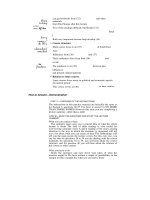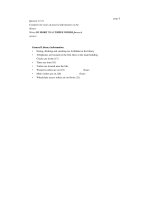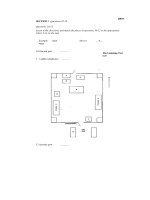Oxford ielts book part 3 doc
Bạn đang xem bản rút gọn của tài liệu. Xem và tải ngay bản đầy đủ của tài liệu tại đây (68.57 KB, 10 trang )
IELTS Preparation, Practice Samples, Free
Books and material.
Which kind of car thief is likely to use a stolen car for committing a
crime?
17 ___________________________________________
How to Answer—Demonstration
STEP 1—OVERVIEW OF THE INSTRUCTIONS
The instruction for questions 12—17 tells you to complete a table It
does not give you any information about what to write in the table
You will have to look at the table itself to see what you need to
write into it
Now look at the instruction for questions 15—17 It tells you to
answer in NO MORE THAN THREE WORDS This means that the
answer might be one word, two words or three words, but it will
not be four words You should jlso know that these answers never
require a contraction like ifoin't
STEP 2—READ THE QUESTIONS AND STUDY HOW YOU HAVE TO
ANSWER
What you can expect to hear
In this test you will hear a police officer giving a talk about ways
to prevent motor vehicle theft By looking at the table for questions
12—14 you can see that the speaker will give some statistics about
motor vehicle theft So you know you will be listening for numbers
What you have to do
Sometimes you will not hear numbers in exactly the form of the
questions You might have to make a simple calculation, as you did
for question 7 in Section 1 If you use the time given for studying
the questions, you will know exactly what kind of information is
needed Then you can quickly put the numbers in as you listen
Also, remember that you can write the numbers as either numerals
or words, or even a combination So it would be easier to write a
number like 108 as a numeral, but a number like 5 billion as a com-
bination of a numeral and a word
In some tests you might have to answer a question with a
combination of numerals and letters, as might be used in a car
registration number or a student registration number You will find
an example of this type of question in Practice Listening test 2
(page 36) Listening exercise 1 on page 29 will give you practice in
listening for numbers, letters and names of places
Analyse questions 15-17 What can you expect to hear' What do
you have to do'
What kind of information are they asking for'
Actually, the first question requires two answers, which is why it
has two numbers The key words in this question are
What are the two kinds of car thieves''
Can you predict any possible answers'
IELTS Preparation, Practice
Samples, Free Books and material.
The key words in question 17 are:
Which kind of car thief is likely to use a stolen car for committing a
crime?
The use of 'which' in this question tells you that the answer is most
likely to be ONE of the answers in questions 15 and 16, but you
will have to listen very carefully to know which one.
NOW START YOUR TAPE
Listen to the first part of the talk and do questions 12-17. Use the
short time given to review the questions.
STOP YOUR TAPE
when you hear the instruction to do so.
Questions 18 and 19
Question 18
Choose the picture A-D which best shows what the police officer
says a
vehicle owner SHOULD DO.
IELTS Preparation, Practice
Samples, Free Books and material.
Question 19
Choose the picture A-D which best shows what the police officer •says
a vehic le owner SHOULD NOT DO
Questions 18 and 19 are based on the second part of the talk about
preventing vehicle theft Look closely at the instructions, the
questions and the pictures Take particular notice of those words in
the questions given in BOLD ITALIC CAPITALS These
emphasise that the first set of pictures is concerned with what you
SHOULD DO, or the right thing to do, and the second set is
concerned with what you SHOULD NOT DO, or the wrong thing
to do
Although it may not be completely clear what the pictures
represent when you first look at them, you will find as you listen to
the talk that they all relate quite clearly to what is said Can you
predict what the answers might lie' Can you eliminate any of the
possibilities' You will now be told to look at the rest ot the
questions for Section 2 before the final part of the talk
START YOUR TAPE
Use the short time provided to look at questions 18 and 19 again
Listen to the rest of the talk and answer questions 18 and 19
IELTS Preparation,
Practice Samples, Free Books and material.
STOP YOUR TAPE
Use the time given at the end to check your answers. Use this time
the best way you can by either going over your answers for Section
2 or by reading the questions for Section 3. Continue until you hear
the instruction to turn to Section 3.
STOP YOUR TAPE
TEST TIPS
• If you need to write your answers more clearly, do so.
• If you have missed any questions, try t,o remember the answers.
• If you can't remember an answer, have a guess.
' If you are happy with your answers, go on and study the
questions
for the next section.
IELTS Preparation, Practice Samples, Free
Books and material.
The Listening Test
Section 3
What is it?
It is a conversation between two or rnore speakers.
It is usually in two parts.
You are given time to look at the questions.
There is no example on the cassette tape.
The topic is often related to student life.
The Questions
THE MAIN STRATEGIES ARE:
analysing the questions
familiarising yourself with the form of the answers
predicting possible answers
eliminating unlikely answers
preparing yourself to distinguish voices.
Now look at the questions for Section 3 of this test.
SECTION 3^ Questions 20-29
Questions 20-27
Complete the table. Use NO MORE THAN THREE WORDS for
each answer. (Note: X means information not given.)
Reading Essays Lectures Seminars
Lisa too interesting handwriting (23)
(25)
word limit
Sasha (20)
(22)
(24)
(26)
Olaf (21)
plagiarism X (27)
IELTS Preparation, Practice Samples, Free
Books and material.
Questions 28 and 29
Choose the torrect letter A, B. C or D
28 Who are Lisa, Olaf and Sasha^
A Lisa is a lecturer Olaf and Sasha are students
B they are all first year foreign students
C Olaf and Sasha are foreign students Lisa is their tutor
D Lisa is a local student Olaf and Sasha are foreign students
29 What does Lisa think of Sasha's last seminar paper''
A it was like a lecture
B it was professional
C it was rather boring
D she couldn't believe it
How to Answer—Demonstration
STEP 1—OVERVIEW OF THE INSTRUCTIONS
You have to complete the tables using NO MORE THAN THREE
WORDS Also, look at the note It tells you that X means there is no
in- formation given for this box, so you know that you will not hear
what problems Olaf has with lectures
STEP 2—READ THE QUESTIONS AND STUDY HOW YOU HAVE TO
ANSWER
What you can expect to hear
The tables show the names of three people and there are four
column headings If there are three people, there must be either two
male or two female voices This means that you will have to
distinguish them from each other and work out which voice
belongs to which person You will find an exercise to practise this
skill on Cassette 2, Side B
From the column headings you should already be able to work
out that the conversation will probably be about study programs
For the first part of the conversation, the introduction on the
cassette tape tells you that for questions 20-24 the people are
talking about study difficulties
What you have to do
Because you know that the people are talking about study
difficulties, and you can see the headings in the table, you have
some clues to possible answers In other words, you might be able
to predict what the answers might
IELTS Preparation,
Practice Samples, Free Books and material.
he On the side of the page, note down your ideas about study
difficulties people might have in relation to reading, writing essays
and listening to lectures Do not write them in the table at this stage
As you listen you can transfer them to the table, or even just use
arrows and write them in during the time you are given at the end
of the section
NOW START YOUR TAPE
Listen to the first part of the discussion and answer questions 20-24
When you have finished this section
STOP YOUR TAPE
Look back at questions 25-29 on pages 22 and 23
What you can expect to hear
For the second part of this section, the instructions on the tape
tell you to complete the last column of the table with what they say
about seminars Difficulties are not mentioned This means that you
might hear comments about seminars that include advantages as
well as difficulties
Read questions 28 and 29 carefully and underline the key terms
Note that question 29 asks you for Lisa's opinion of Sasha's last
seminar paper Do you expect her to say something good or bad
about the paper'
What you have to do
This time you should make a note of both advantages and
difficulties of seminars in the margin of your booklet It is possible
that you can already answer question 28 from the information you
have heard so far
START YOUR TAPE
Complete questions 25-29 and then let your tape continue until
your hear the instruction to turn to Section 4 Again, use this time
either to go over your answers to Section 3 or to go on to look at
Section 4
STOP YOUR TAPE
TEST TIPS-
• Don't worry if you hear a lot of extra information between
questions.
• The information you need to answer a question is often
repeated
• The words in the answer choices are often synonyms of the
words
you hear
IELTS Preparation, Practice Samples,
Free Books and material.
The Listening Test
Section 4 ___________________
What is it?__________________
• It is a monologue.
• It is usually not divided into parts, although there may be
short pauses.
• There is often a written example in the question booklet,
but there
is not a separate spoken example. /
• The questions to this section are often in the form of notes
or a summary to be completed. However, there is
sometimes a mixture of question types, as in Listening test
Section 3 in this book.
• It is usually a short talk or lecture similar to what you
might hear at the beginning of a course, but you do not
need specialist knowledge to understand the ideas
presented.
The Questions
THE MAIN STRATEGIES ARE:
' reading the notes or summary quickly
• predicting possible answers
• taking notes as you listen.
SECTION 4 Questions 30-40
Complete the following lecture summary. Write NO MORE THAN
THREE WORDS for each answer.
South-East Asian Traditions
Example
Course
Coordinator
Answer
Paul
Stange
• Course materials
two textbooks—Osborne and Legge
(30)
(31)
continued
overleaf
IELTS Preparation,
Practice Samples, Free Books and material.
can get textbooks from (32) and other
materials
from Paul Stange after this lecture
Two of the readings difficult, but Bender (33)
Smal
l
Both very important because help develop (34)
• Course structure
Main course focus is on (35) of South East
Asia
Influences from (36) and (37)
These influences have been both (38) and
social
The emphasis is on (39) between past
influences
and present cultural patterns
• Relation to other courses
Later courses focus more on political and economic aspects
of modern period
This course serves as (40)
How to Answer—Demonstration
STEP 1—OVERVIEW OF THE INSTRUCTIONS
The instructions in this practice material are basically the same as
for Section 3, questions 20-27 You have to answer in NO MORE
THAN THREE WORDS However this time you are completing a
lecture sumrmry, rather than a table
STEP 2—READ THE QUESTIONS AND STUDY THE LECTURE
SUMMARY
What you can expect to hear
The summary notes give you a general idea of what the whole
lecture is about The skill of skim reading is very useful for
overviewmg summary notes A quick reading of the notes, paying
attention to the way in which the summary is organised will tell
you a lot about what you can expect to hear The subheadings will
tell you the main points the lecture covers For this exer cise, you
can see that for questions 30 to 34 you are dealing with the course
materials, for questions 35 to 39, you will hear about the course
structure, and for question 40 you will hear about the relation of
this course to other courses
What you have to do
Study the summary and note down your ideas of what the
answers might be We have written a couple of possibilities in the
margin for this example See what you can add to them
to later courses
IELTS Preparation,
Practice Samples, Free Books and material.
• The first thing to note is the heading at the top of the summary It
tells you
that the lecture is about traditions in South-East Asia What kind
of traditions might they be' Can you get any clues from the
notes'
• Questions 30 and 31 What other course materials might you
expect to need
for such a course'
• Question 32 Where, or from whom, might you expect to get your
textbooks'
• Question 33 The sentence structure gives you a clue that this
question
probably requires a comparison between the two textbooks, so
the words might include 'more than' or 'less than' or some other
form of a comparative Looking at the rest of the sentence and
the one that follows, you suspect that one book is more difficu!t
than the other, so think of some other expressions with this
meaning that you might expect to hear If you hear a word that
means the same as difficult, for example, you could still write
'more difficult than' or 'less difficult than' as appropriate, and be
correct
• Question 34 asks you what the two textbooks help to develop
What can
you develop by reading a textbook'
The second part of this lecture is concerned with the course
structure It looks at the focus and emphasis of the course and at
influences in Sout/i-Eost Asia Here it is useful to keep the heading
in mind The introduction on the cassette tells you that the course is
an introduction On what aspects of South- East Asia would you
expect an introductory course to concentrate' You can see from the
notes that the other aspect looked at here relates to influences What
kind of influences do you think they might be and who or what did
the influencing'
The final question, question 40, asks you about the relation to
other courses, and specifically to later courses What kind of
relationship does an introductory course usually have to a later
course' Study the question page for this section (pp 25-6), and
consider the way in which a test candidate might have marked the
sheet before the section began Add your own notes and underlining
to the page
NOW START YOUR TAPE
Listen to Section four and complete the summary
STOP YOUR TAPE
when it tells you that you have half a minute to check your answers
At the end of the Listening test you are always given time to go
back through the whole test and complete any answers you have
not filled in yet It is extremely unlikely that you will be able to
recall any detailed information, particularly from the earlier parts
of the test What you can do is write in any answers from notes you
may have made in the margin You can also check carefully that
you
have marked exactly what the instructions require
You will then have ten minutes to transfer all your answers to the
answer sheet In a real test the timing for this is incorporated into
the test cassette For the tests in this book, you will have to time
yourself It is important that you transfer your answers appropriately
If you are instructed to circle the letters in the test booklet, make
sure you transfer those letters and not the actual answers, so as not
to waste time For questions requiring no more than three words,
make sure this is the maximum number of words you write









